 Class 1: Explosive Class 1: Explosive
|
| Class 1 includes explosives and is classified by 6 divisions. |
| LABEL | DIVISION | DEFINITION |
 |
1.1 | Explosives with a mass explosion hazard |
 |
1.2 | Explosives with a severe projection hazard. |
 |
1.3 | Explosives with a fire, blast or projection hazard but not a mass explosion hazard |
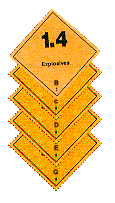 |
1.4 | Minor fire or projection hazard |
 |
1.5 | Very insensitive substances which have a mass explosion hazard |
 |
1.6 | Extremely insensitive substances which do not have a mass explosive hazard |
 Class 2: Gases Class 2: Gases
|
| Class 2 consists of compressed gas, liquefied gas, frozen liquefied gas, solution gas, products filled with gas and aerosol. Class 2 is classified as below. |
| LABEL | DIVISION | DEFINITION |
 |
2.1 | Gases that are completely gaseous at 20°C and at a standard pressure of 101.3 kPa. |
 |
2.2 | Gases transported by compressing it at 20°C and at a standard pressure of 280kPa, or as frozen liquid, or as chokedamp gas, or as oxidizing gas, or gases that are not in any other classes. |
 |
2.3 | Toxic or corrosive gas |
| * Gas means material which has a vapour pressure greater than 300kPa at 500C or which is gaseous at 20°C and at a standard pressure of 101.3 kPa. |
 Class 3: Flammable Liquids Class 3: Flammable Liquids
|
| Class 3 includes flammable liquids or liquid desensitized explosives. |
 Flammable liquids refers to liquid, liquid mixture, solution, suspension that emit flammable atmosphere under a flash point under 60°C in the test using closed cup method. It includes liquid of which flash point is above 60 that is carried at a temperature above its flash point and material that emit flammable atmosphere under the maximum transport temperature which is transported as liquid at a high temperature. Flammable liquids refers to liquid, liquid mixture, solution, suspension that emit flammable atmosphere under a flash point under 60°C in the test using closed cup method. It includes liquid of which flash point is above 60 that is carried at a temperature above its flash point and material that emit flammable atmosphere under the maximum transport temperature which is transported as liquid at a high temperature.
Liquid desensitized explosives refer to stable liquid mixture which is absolved by other liquid or floated to restrain its explosiveness. It consists of UN No. 1204, 2059, 3064 and 3343. The flash point is the lowest temperature at which a liquid will generate enough vapor to form an ignitable mixture at its surface. It refers to the lowest temperature at which flash is observed when certain amount of liquid is heated. The flash point should be measured by closed up method. Liquid means dangerous material which has a vapour pressure lower than 300kPa at 500C or which is not gaseous at 20°C and at a standard pressure of 101.3 kPa. Class 3 is classified following three packing groups according to degree of danger. |
| PG(Packing Group) | Flash Point(℃, c.c.) | Initial Boiling Point(IBP)(℃) |
| I | - | ≤ 35 °C |
| II | < 23°C | > 35°C |
| III | ≥ 23°C ≤ 60°C, > 35°C |
 Class 4: Flammable Solids Class 4: Flammable Solids
|
| (Flammable solids ; Substances liable to spontaneous combustion ; Substances which, in contact with water, emit flammable gases) |
| Class 4 consists of substances that are not classified as chemicals and flammable. Class 4 is classified as below. |
| LABEL | DIVISION | DEFINITION |
 |
4.1 Flammable solids | A solid which is steadily combustible, or may cause/contribute towards fire through friction. A self-reactive or related substance which is liable to undergo a strongly exothermic reaction. A desensitized explosive where the explosive properties have been suppressed. |
 |
4.2 Spontaneously combustible | A substance which is liable to spontaneous combustion under conditions met in carriage or liable to self-heating when in contact with air, and liable to catch fire. |
 |
4.3 Dangerous when wet | A substance which in contact with water is liable to become spontaneously combustible or to give off a flammable gas |
| * Solid means dangerous article that is not liquid(excluding gas) * Self-reactive substance is a substance that may undergo exothermic self accelerating decomposition without air, thus unstable regarding heat. * Solid desensitized explosives is a solid that is damped by water or alcohol or diluted by other substances to restrain its explosiveness. * Pyrophoric substance is a substance that will ignite spontaneously within 5 minutes in air. * Self-heating substances is a substance that will heat in air without other energy supply. |
 Class 5: Oxidizing substances and Organic Peroxides Class 5: Oxidizing substances and Organic Peroxides
|
| Class 5 consists of Oxidizing substances and Organic Peroxides, and it is classified as below. |
| LABEL | DIVISION | DEFINITION |
 |
5.1 Oxidizing substances | A substance other than on organic peroxide, which although not necessarily combustible, may by yielding oxygen or by a similar process cause/contribute to the combustion of other material. |
 |
5.2 Organic Peroxides | A substance which is an organic peroxide; and an unstable substance which may undergo exothermic self accelerating decomposition. |
 Class 6: Toxic and Infectious Substances Class 6: Toxic and Infectious Substances
|
| Class 6 consists of toxic and infectious substances, and it is classified as below. |
| LABEL | DIVISION | DEFINITION |
 |
6.1 Toxic substances | A substance which is liable either to cause death or serious injury or to harm human health if swallowed or inhaled or by skin contact. |
 |
6.2 Infectious substances | A substance which either contains viable micro-organisms that are known or believed to cause disease in animals or humans, or genetically-modified micro-organisms and organisms which may be infectious. |
| 6.1 is subdivided by packing groups as below. |
| Oral,Dermal and Dust/Mist Inhalation Hazards Division 6.1 Packing Group Criteria |
| Packing Group | Oral Toxity LD50(mg/kg) | Dermal Toxictiy LD50(mg/kg) | Dust/Mist Inhalation Hazard LC50(mg/l) |
| I | ≤ 5 | ≤ 50 | ≤ 0.2 |
| II | > 5, but ≤ 50 | > 50, but ≤ 200 | > 0.2, but ≤ 2.0 |
| III | > 5, but ≤ 300 | > 200, but ≤ 1000 | > 2.0, but ≤ 4.0 |
| Tear gas should belong to packing group II although its toxic reference belongs to packing group lll |
| Vapour Inhalation Hazard-Division 6.1 Packing Group Criteria |
| Packing Group | Vapour Inhalation Hazard |
| I | In the case that V ≥ LC50 and LC50≤ 1,000 m/L/m3 |
| II | In the case that V ≥ LC50 and LC50≤ 3,000 m/L/m3, and it does not belong to packing group l |
| III | In the case that V ≥ 0.2 LC50 이고, LC50 ≤ 5,000 m/L/m3 and it does not belong to packing group ll |
| "V" means at 20°C and saturated vapor pressure(ml/ m3) of standard atmospheric pressure. |
| 6.2 is categorized according to standards as below. |
| Category A : In the case that substance is discharged during transportation and the discharged substance can cause permanent disability, fatal threat, or serious damage if it is exposed to healthy human or animal, it is classified as UN2814 (Infectious substance affecting humans); if it is harmful only to animal, it is classified as UN2900(Infectious substance affecting animal only) |
Category B : Infectious Substances do not belong to category A is classified as UN3373 (Biological substance, Category B). |
 Class 7: Radioactive Materials Class 7: Radioactive Materials
|
| According to the types of materials, there are some materials that self-emit radiation, and this quality is called radioactivity. Materials having radioactivity is called radioactive material. In nature, almost all the materials emit some radiation. Therefore, radioactive materials classified as dangerous goods are ones emitting radiation above radioactive concentration limit and radioactivity limit for each cargo, and having radio-nuclide. Below radioactive materials are not classified radioactive materials although in fact they are. * Radioactive materials injected or transplanted to inside the body of human or animal for diagnosis or medical treatment. * Radioactive materials belongs to the consumer goods of which sales to the final consumer is authorized. For radioactive materials continue to emit radiation, they should be strictly managed and transporting container should be designed and produced by experts to emit radiation under permissible limit. |
  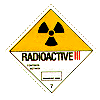 |
 Class 8: Corrosive Materials Class 8: Corrosive Materials
|
 A substance which by chemical action will cause severe damage when in contact with living tissue and cause damage to other freight or equipment on the vehicle if leakage occurs. Its packing groups are categorized by considering additional factors such as reaction to water or danger of inhalation. A substance which by chemical action will cause severe damage when in contact with living tissue and cause damage to other freight or equipment on the vehicle if leakage occurs. Its packing groups are categorized by considering additional factors such as reaction to water or danger of inhalation.
The packing group can be categorized by the length of period it takes to destroy the whole thickness of human skin. Materials that have potential to corrode part of surface of metal can be classified as corrosive materials, although they do not destroy whole thickness of human skin. |
| Packing groups of corrosive materials are categorized as below. |
| * Packing Group I - If the skin tissue used in the test begin to destroy within 3 minutes, and it is destroyed within 60 minutes. * Packing Group II - If the skin tissue used in the test begin to destroy after 3 minutes and before 60 minutes, and it is fully necrotized before 14 days. * Packing Group III - If the skin tissue used in the test begin to destroy after 60 minutes and before 4 hours, and it is fully necrotized before 14 days. Or materials that shows corrosive rate 6.25mm per year to surface of steel or aluminium at 55 °C although it does not fully nectrotize skin tissue. |
 Class 9: Miscellaneous Dangerous Goods Class 9: Miscellaneous Dangerous Goods
|
 Class 9 includes goods that does not belong to previous 8 classes but that can cause danger during transportation process. Substances as below belong to Class 9. Class 9 includes goods that does not belong to previous 8 classes but that can cause danger during transportation process. Substances as below belong to Class 9.
|
| Substances emitting dangerous smell, substances possessing magnetic forces(Classified as dangerous goods for it could influence flight) |
| * If GMMOs that does not belong to 6.2 group, they belong to UN3245 Genetically modified micro-organisms ,Genetically modified organisms.
* Substances that have magnetic forces above 0.159A per meter 2.1m away from outside surface of package( Its magnetic force can influence electronic parts of airplane, thus classified as dangerous goods) * Substances that are anesthetic or toxic which can disrupt plight attendants to perform their duty when spilled causing extreme revulsion or discomfort. Substances including things to be transported at high temperature, dry ice, and car are typical substances of Class 9. |
| Other supplementary provisions labels of dangerous goods. |
| LABEL | Purpose | LABEL | Purpose |
 |
Marks the top and bottom of cargo | 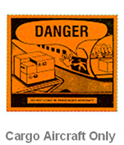 |
cargo air craft only(Prohibited on passenger plain) |
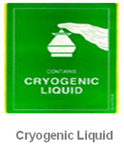 |
Cryogenic liquid(Substance evaporating at room temperature) |  |
Substances that needs to keep away from direct light and heat |
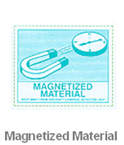 |
Magnetized material | 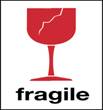 |
fragile(fragile cargo) |
 |
Pollutant |

































